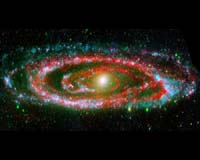An Amazing Andromeda

By Aussiegirl
THE WORLD is charged with the grandeur of God.
It will flame out, like shining from shook foil;
It gathers to a greatness, like the ooze of oil
Crushed. Why do men then now not reck his rod?
Generations have trod, have trod, have trod;
And all is seared with trade; bleared, smeared with toil;
And wears man’s smudge and shares man’s smell: the soil
Is bare now, nor can foot feel, being shod.
And for all this, nature is never spent;
There lives the dearest freshness deep down things;
And though the last lights off the black West went
Oh, morning, at the brown brink eastward, springs—
Because the Holy Ghost over the bent
World broods with warm breast and with ah! bright wings.
[Gerald Manley Hopkins]
Such a wonderful universe we inhabit, full of beauty and violence.
An Amazing Andromeda
An Amazing Andromeda
by Staff Writers
Pasadena CA (JPL)
The many "personalities" of our great galactic neighbor, the Andromeda galaxy, are exposed in this new composite image from NASA's Galaxy Evolution Explorer and the Spitzer Space Telescope. The wide, ultraviolet eyes of Galaxy Evolution Explorer reveal Andromeda's "fiery" nature -- hotter regions brimming with young and old stars.
In contrast, Spitzer's super-sensitive infrared eyes show Andromeda's relatively "cool" side, which includes embryonic stars hidden in their dusty cocoons.
Galaxy Evolution Explorer detected young, hot, high-mass stars, which are represented in blue, while populations of relatively older stars are shown as green dots. The bright yellow spot at the galaxy's center depicts a particularly dense population of old stars.
Swaths of red in the galaxy's disk indicate areas where Spitzer found cool, dusty regions where stars are forming. These stars are still shrouded by the cosmic clouds of dust and gas that collapsed to form them.
Together, Galaxy Evolution Explorer and Spitzer complete the picture of Andromeda's swirling spiral arms. Hints of pinkish purple depict regions where the galaxy's populations of hot, high-mass stars and cooler, dust-enshrouded stars co-exist.
Located 2.5 million light-years away, the Andromeda is our largest nearby galactic neighbor. The galaxy's entire disk spans about 260,000 light-years, which means that a light beam would take 260,000 years to travel from one end of the galaxy to the other. By comparison, our Milky Way galaxy's disk is about 100,000 light-years across.
This image is a false color composite comprised of data from Galaxy Evolution Explorer's far-ultraviolet detector (blue), near-ultraviolet detector (green), and Spitzer's multiband imaging photometer at 24 microns (red).


0 Comments:
Post a Comment
<< Home